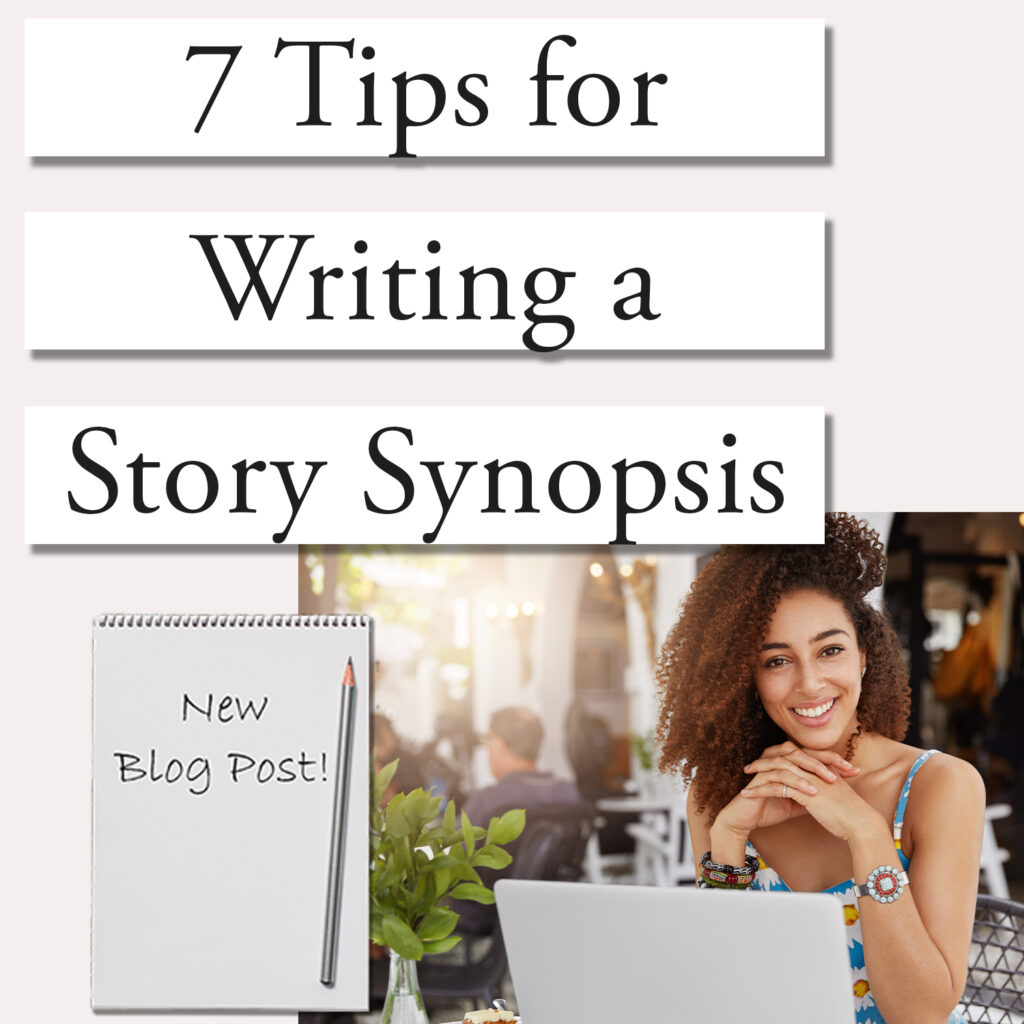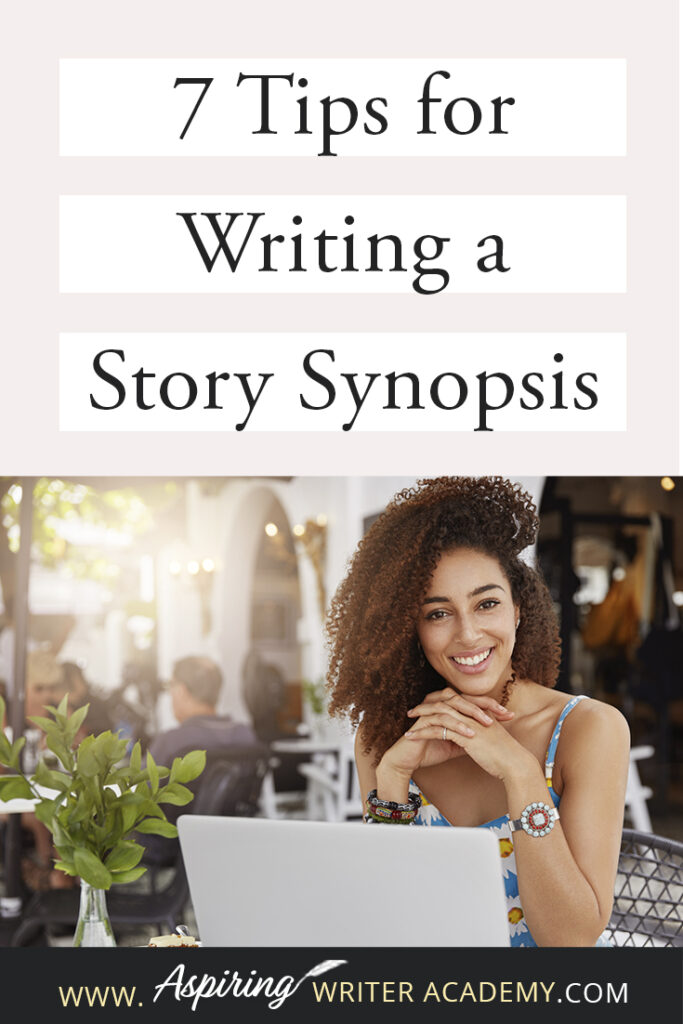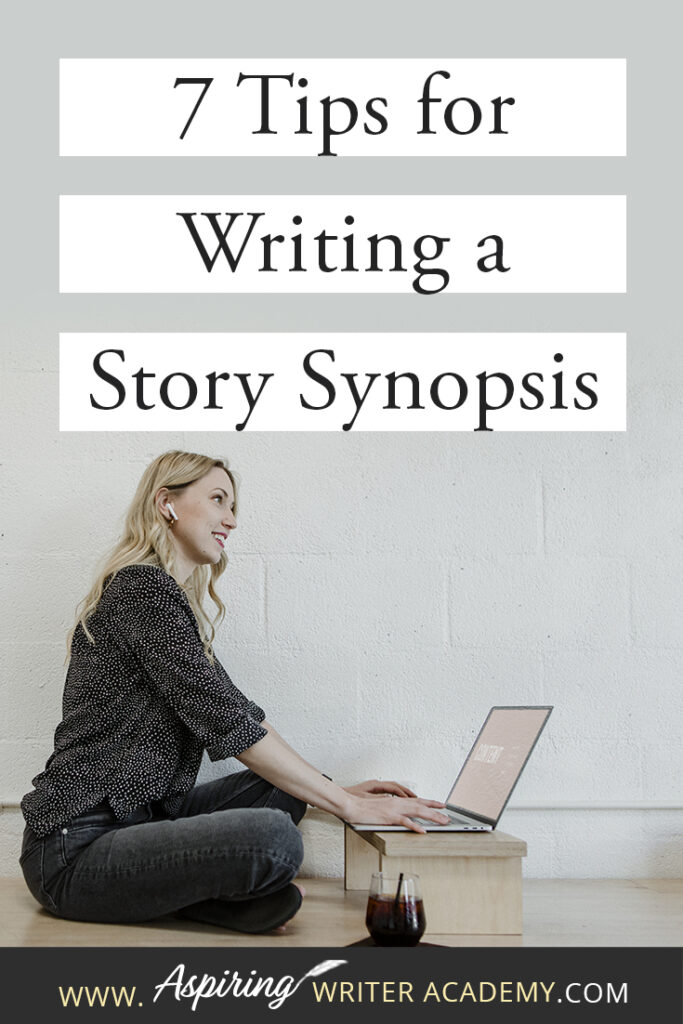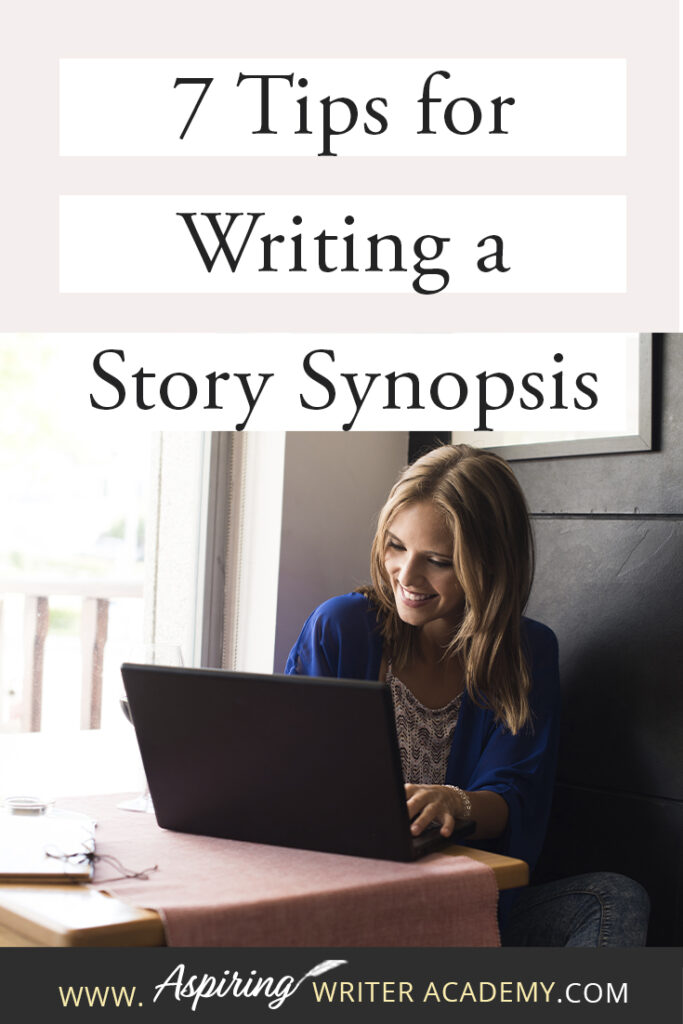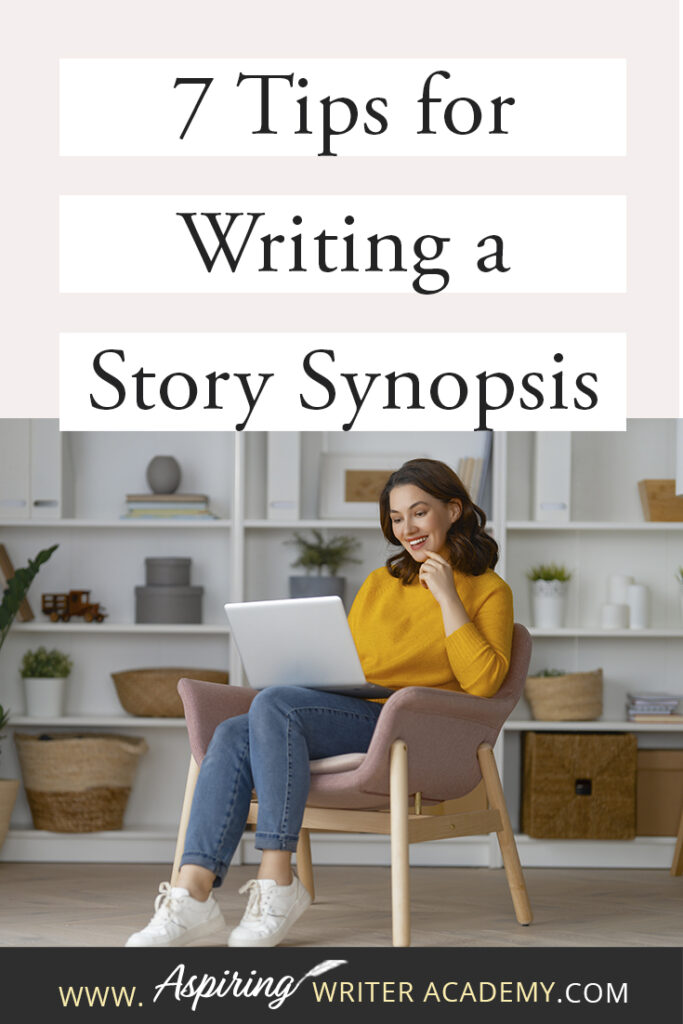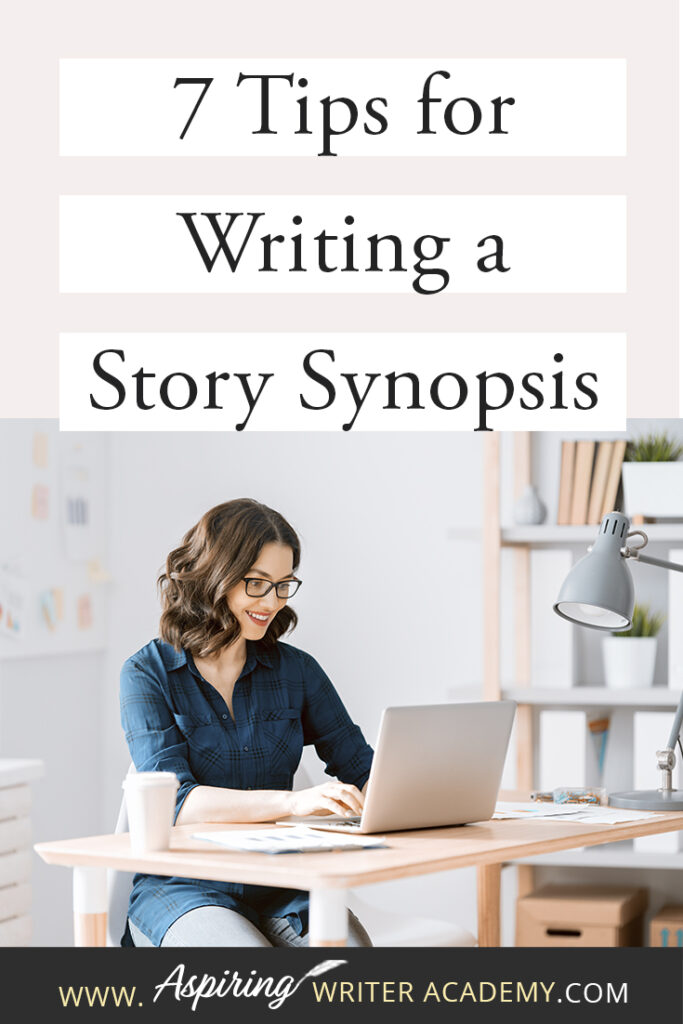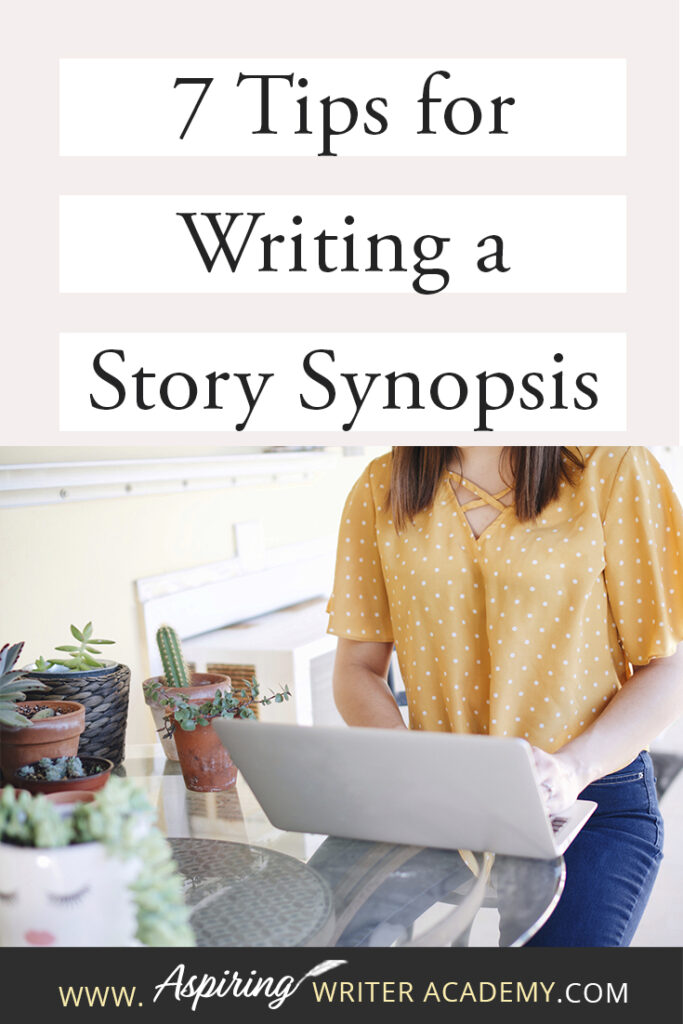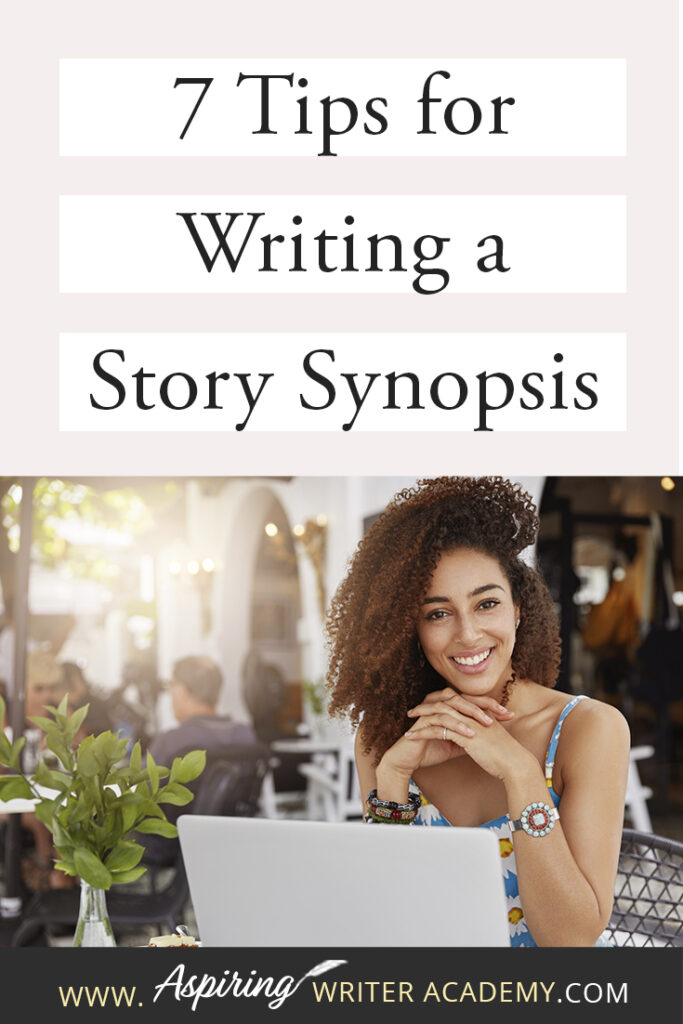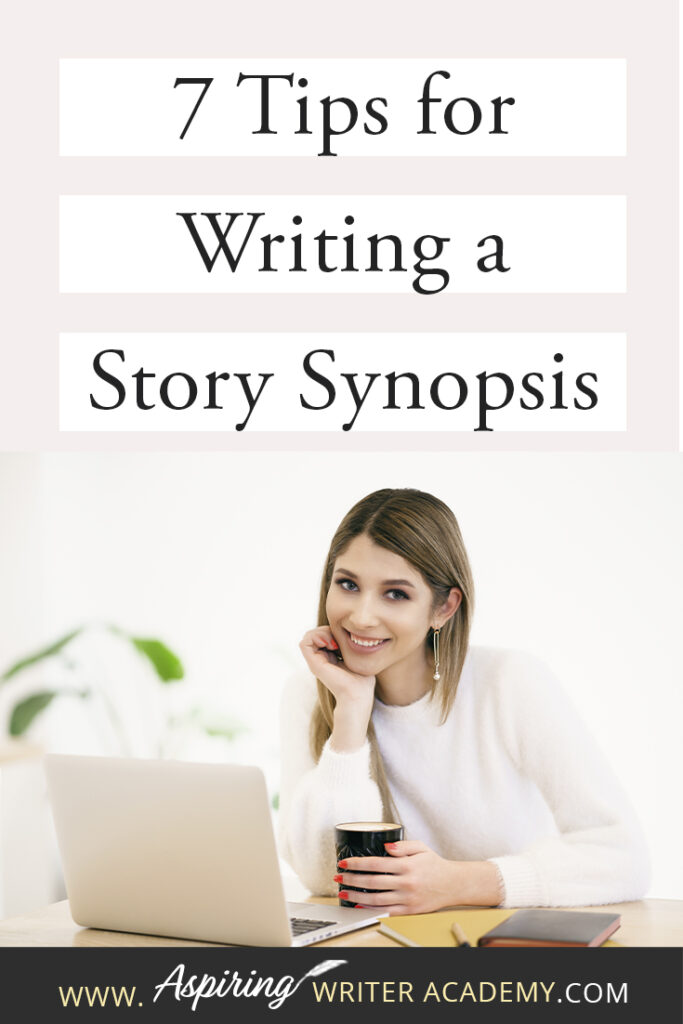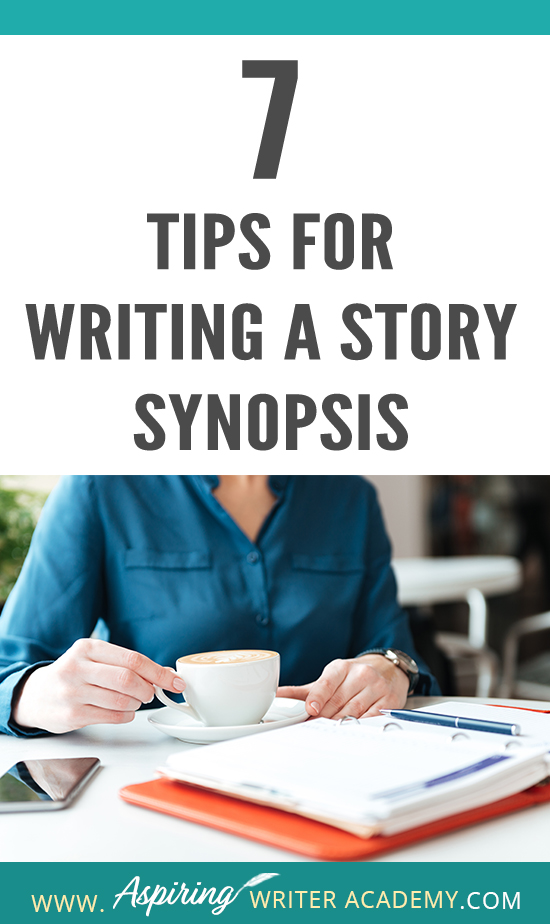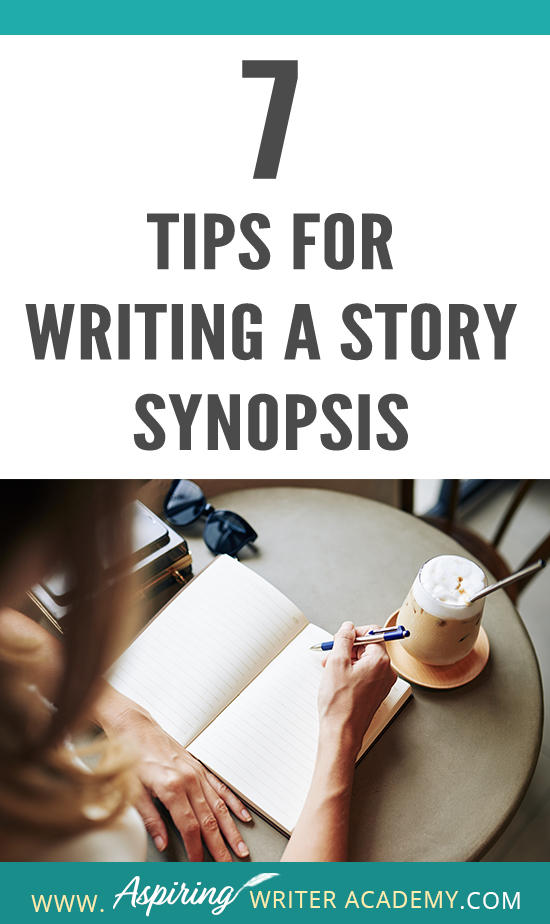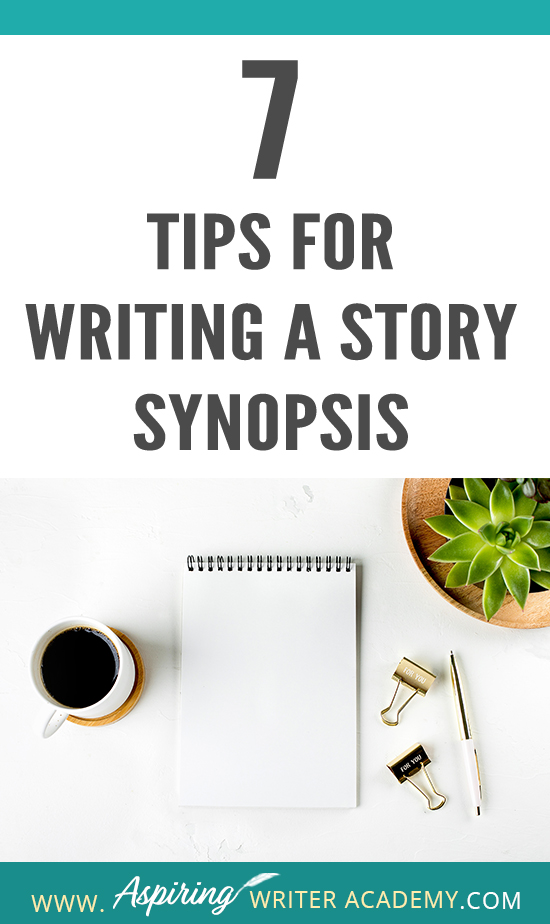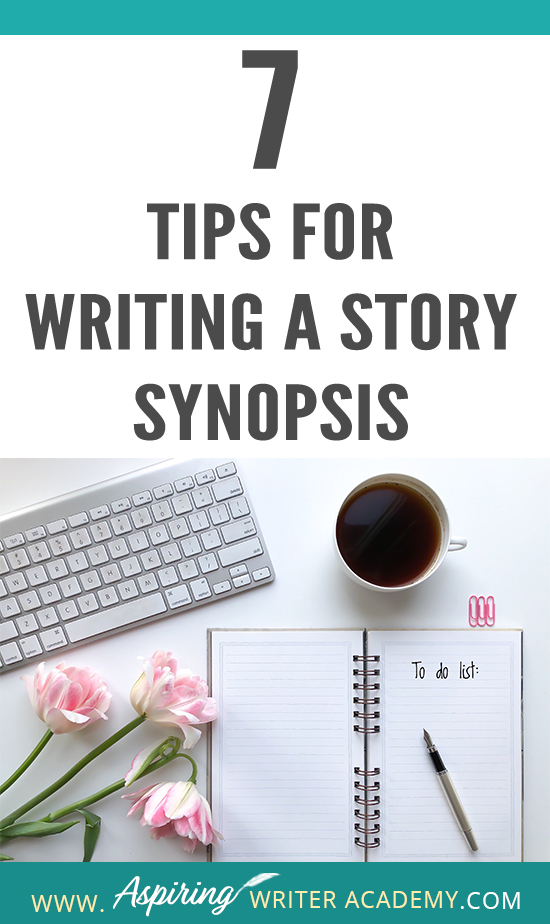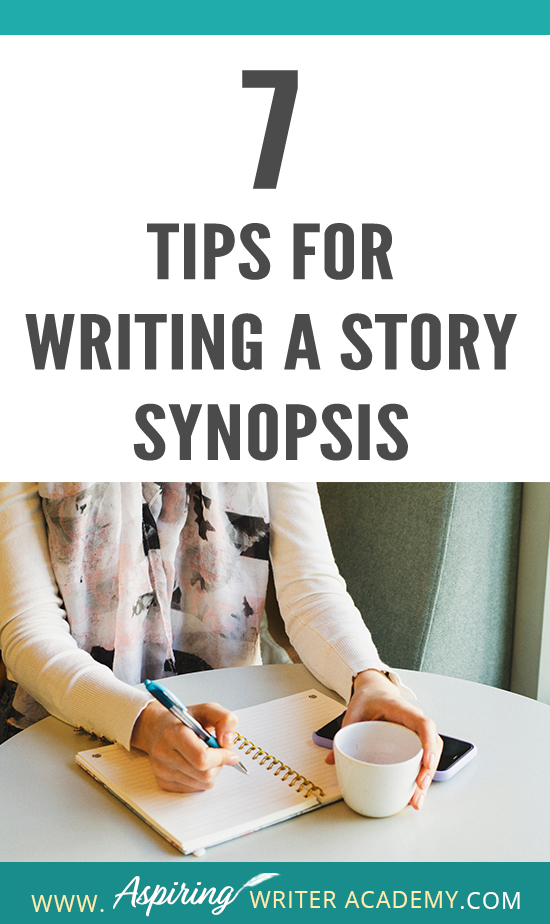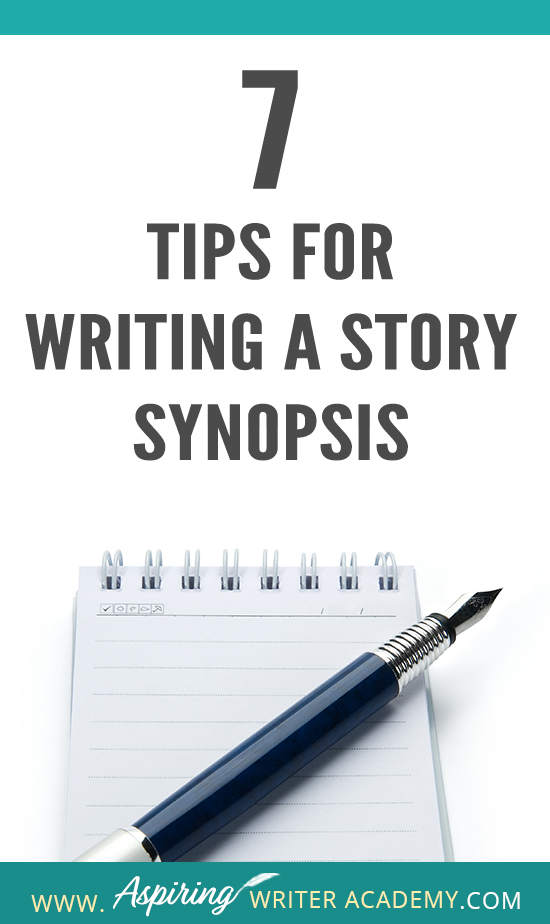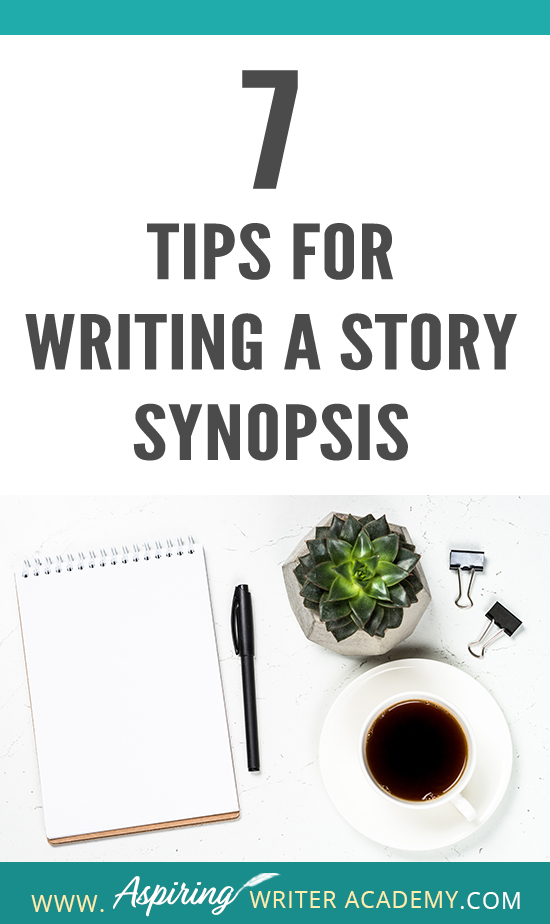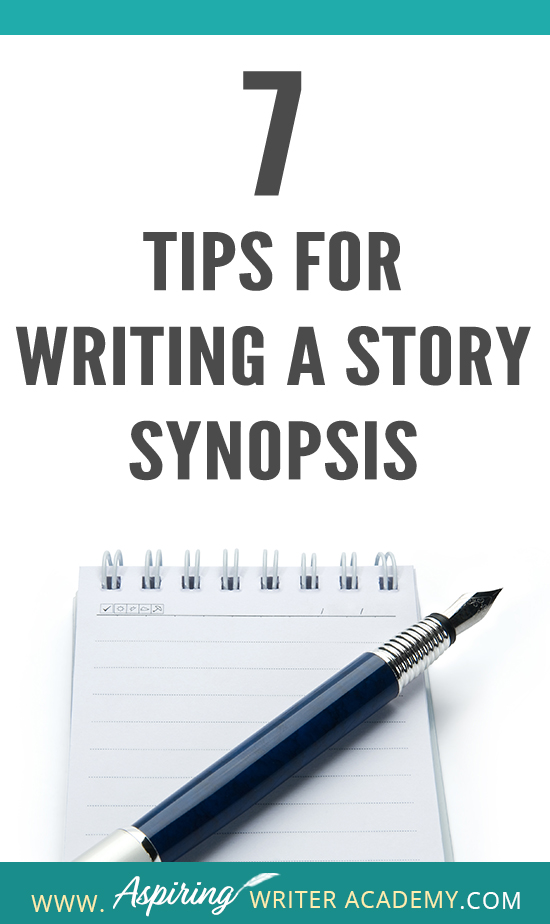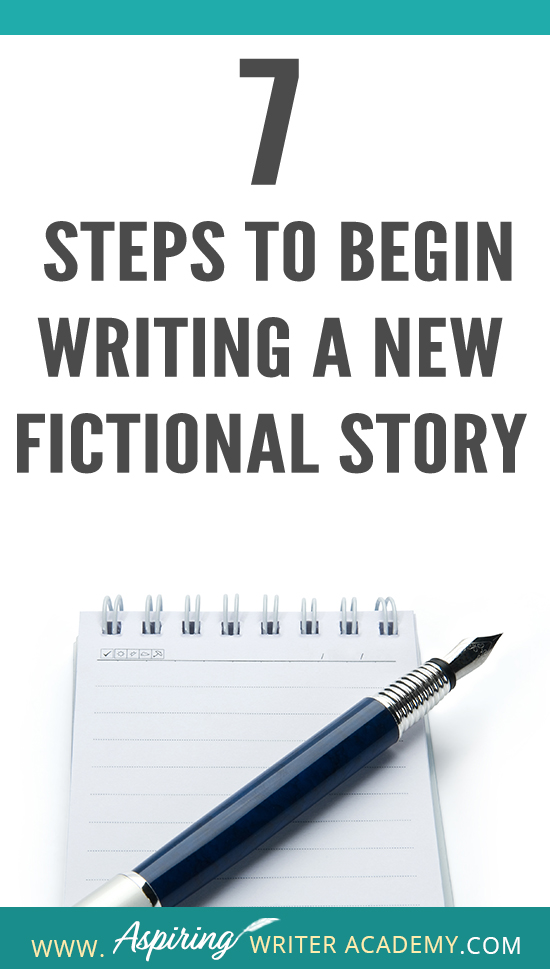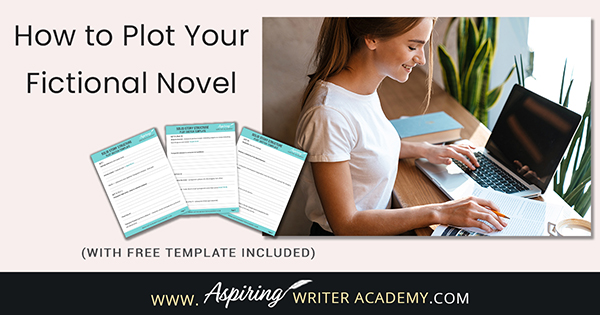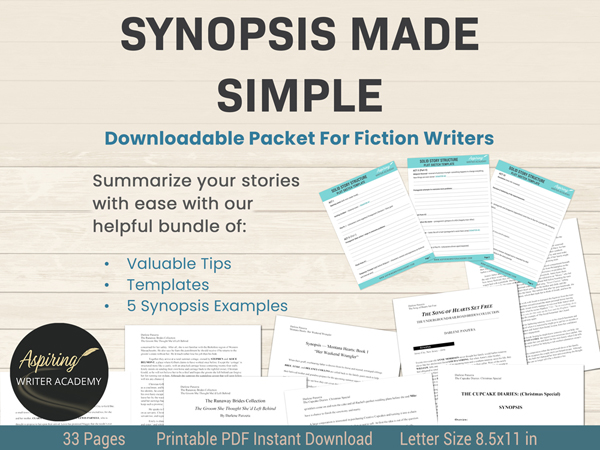7 Tips for Writing a Story Synopsis
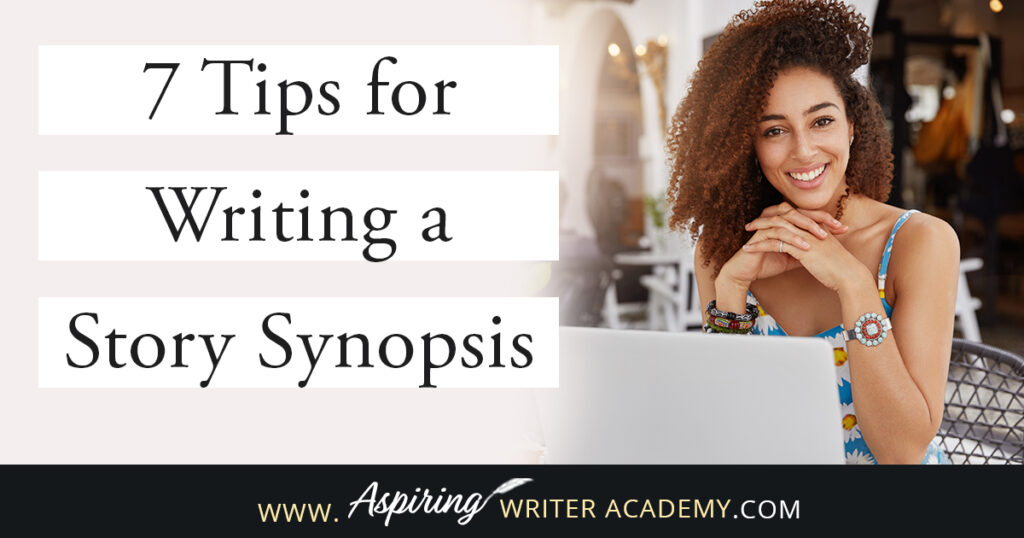
Ask any writer about the dreaded story ‘synopsis’ and you will most likely hear lots of moans and groans. How do you condense the plot of an entire book into just 2 or 3 pages? What should be included? How should it be formatted? How should characters be introduced?
Join us as we discuss 7 Tips to Write a Story Synopsis to help simplify the process so that you can confidently and successfully write a story synopsis with ease.
First, before we go any further, let’s address:
What is a story synopsis?
A story synopsis is a summary of your manuscript, a quick snapshot of the characters involved and the main plot points that unfold from beginning to end. Usually about 2 to 6 pages in length, the synopsis is included in a book proposal sent to an acquiring editor or agent.
When I first started writing a book and went to my first writer’s conference, I was just learning the writer lingo thrown around by seasoned authors, such as ‘plot points,’ ‘submission package,’ ‘query letter,’ and yes, the ‘synopsis.’
I had never written a synopsis of my book before.
While how-to books on the craft of writing and taking classes are helpful, having a mentor who can sit down next to you and show you exactly how it is done is a golden opportunity. I have had several mentors direct my paths over the years, but at this stage in my budding career, it was New York Times best-selling author, Jill Barnett, who randomly invited about five of us newbies to meet her during a break session of a conference. We sat in a circle on the floor, and she generously taught us the basics of writing a synopsis for our fictional novels for which I am forever grateful.
Since then, I’ve learned more tips on how to write a story synopsis, which I would like to share with you in the post below.
And as a special bonus, (if you scroll to the bottom), I will give you a link to download five of my story synopsis’s that led to a publishing contract to help guide you as you write your own.
In 7 Tips to Write a Story Synopsis, follow along as we discuss:
1) Proper Formatting
2) Preferred Tense
3) Capitalization of Names
4) Tell, don’t Show
5) Goals, Motivation, and Conflict
6) The Plot Sketch Outline
7) How Does it End?
1) Proper Formatting
Tip #1: Use Microsoft Word, Single Spaced, 12-Point Times New Roman Font. Aim for 2-5 Pages in Length.
Your story synopsis should be about 2 to 3 pages long (5 to 6 pages max). Use Microsoft Word single spaced 12-point Times New Roman font. Courier New may also be acceptable.
If using Scrivener or some other writing program instead of Microsoft Word, make sure it can export your synopsis using a format acceptable to the publisher you wish to send it to.
Always double-check the submission guidelines of the publishing house to see the format, font, and number of pages they prefer for the synopsis. If you meet an acquiring editor or agent in person, feel free to ask how they would like the synopsis formatted. Some editors and agents accepting book proposals insist on a two-page synopsis while others may be more lenient and allow you up to six pages.
Insert a header with your full name with the book title beneath it in the upper left-hand corner of the page.
Example:
Darlene Panzera
Montana Hearts
Center your book title and the word ‘Synopsis’ at the top of the first page.
Example:
Montana Hearts Synopsis
You should also insert page numbers that the editor or agent can reference in their comments back to you. I prefer to insert my page numbers in the footer’s bottom right corner of the document.
2) Preferred Tense
Tip # 2: Use Present Tense.
Use present tense for the synopsis, even if the novel will be written in first person or third person past tense. This tells the story as it unfolds. Almost all editors and agents require the synopsis to be written in present tense. This can be a bit awkward to do at first, so be careful of your verbs in each sentence that you write to make sure you keep the ‘tense’ consistent.
Instead of:
Clara found out that her husband cheated on her. Then she got a new apartment.
(Third person past tense).
Use Present Tense:
Clara finds out that her husband cheated on her, and she gets a new apartment.
3) Capitalization of Names
Tip #3: Capitalize Character Names When They Are First Mentioned.
Capitalize the full name of a character the first time he or she is mentioned in the synopsis. If their name is used again, do not capitalize. You might also use ‘Bold’ font to make the name stand out.
Example:
CAROL GREEN, a middle school art teacher…
And later in the text you might have:
Carol does not believe that more than five colors should be used in a single painting, but when she meets MR. LAWRENCE TAYLOR, a prestigious artist visiting from France, her eyes are opened, and she considers new possibilities.
4) Tell, Don’t Show
Tip #4: Tell the Story in Clear, Concise, Easy-to-Understand Sentences.
Yes, you are telling the story in a synopsis. Most writing instructors will repeatedly say, “Show, don’t tell” when writing your fictional novel. However, when writing a synopsis, you will want to do the opposite. Tell, don’t show! There simply isn’t room in a 2-to-5-page summary. Save that for the book.
Also make sure that the text in your synopsis is clear, concise, and makes sense. Use full sentences. Because you are telling the story, it is acceptable to use ‘and,’ ‘but,’ ‘however,’ and other add-on clauses to help combine sentences so that it reads smoothly like a mini story.
5) Goals, Motivation, and Conflict
Tip # 5: Feature Your Character’s Goals, Motivation, and the Conflict/Opposition.
Introduce the main character, a few adjectives to describe their profession or personality, and briefly explain why they want or need to achieve their story goal.
If there is an antagonist or villain trying to stop the main character from achieving his goal, make sure you also include his reasons for doing so. Why do the characters do what they do? What are the consequences if each of them fails?
If the opposition is a disability the character is trying to overcome or a force of nature like an approaching hurricane, the threat, and consequences of failing to overcome the threat need to be stated.
It is very hard to condense an entire story into just a few pages which is why you must leave out many of the subplots and focus on the main plot points in the manuscript. You do not need to name or list every sub-character who will play a part in your fictional novel.
6) The Plot Sketch Outline
Tip #6: Summarize Each Major Plot Point
After you introduce your main characters, their descriptive adjectives, goals, motivation, the opposition, and what is at stake in this conflict, use the Plot Sketch Outline to write your synopsis from beginning to end. Start at the opening scene incident and go straight on through from point to point until you reach the end. Basically, you are connecting each plot point using full sentences. (Remember to leave out most of the subplots, mentioning them only as they impact the main story line.) You will not detail every single event but focus only on the major turning points that impact the story.
Let your writing style shine through. Rotate the perspective of the story developments for each character just as you might switch POV (point of view) back and forth between characters in the story. Just make sure the sequences flow in a smooth, natural way.
It is also okay to include a memorable line of dialogue or two to give the synopsis some ‘spark’ to show your writing style. Just don’t overdo it. You need to write the narrative in the shortest, most concise way possible.
Click to see our post: How to Plot Your Fictional Novel (with Free Template Included)
7) How Does it End?
Tip # 7: Don’t Forget to Include the Ending.
Do not get mysterious, vague, or cutesy and try to hide the outcome of the story. The editor or agent will want to know exactly how it ends. Do not imply that they will need to read the whole story to find out what happens, or you will get a big fat rejection. The publisher needs to know if you have what it takes to tell a complete story and then they must consider if they think such a story will sell. If you do not know how your story ends, then you are not ready to write a synopsis. You need to have at least a basic notion as to how the story unfolds and is resolved.
Optional Special Bonus:
Download our 33-page Synopsis Made Simple For Fiction Writers Bundle for $5.25
Struggling to condense your intricate plots and rich characters into a 2–5-page document for potential publishers? Our 33-page Synopsis Made Simple For Fiction Writers Bundle, offers valuable tips, templates, and 5 synopsis examples to help you create an engaging summary of your fictional story.
Final Recap:
7 Tips for Writing a Story Synopsis
Tip #1: Use Microsoft Word, Single Spaced, 12-Point Times New Roman Font. Aim for 2-5 Pages in Length.
Tip # 2: Use Present Tense.
Tip #3: Capitalize Character Names When They Are First Mentioned.
Tip #4: Tell the Story in Clear, Concise, Easy-to-Understand Sentences.
Tip # 5: Feature Your Character’s Goals, Motivation, and the Conflict/Opposition.
Tip #6: Summarize Each Major Plot Point
Tip # 7: Don’t Forget to Include the Ending
We hope you have enjoyed 7 Tips for Writing a Story Synopsis and that you can use the information provided to craft a synopsis that conveys your story idea in a concise manner that will earn an editor’s respect. We wish you the best with your writing!
If you have any questions or would like to leave a comment below, we would love to hear from you!
If you like more help developing your story, you may wish to download our Free Brainstorming Your Story Idea Worksheet
Do you find it difficult to create compelling antagonists and villains for your stories? Do your villains feel cartoonish and unbelievable? Do they lack motivation or a specific game plan? Discover the secrets to crafting villains that will stick with your readers long after they finish your story, with our How to Create Antagonists & Villains Workbook.
This 32-page instructional workbook is packed with valuable fill-in-the-blank templates and practical advice to help you create memorable and effective antagonists and villains. Whether you're a seasoned writer or just starting out, this workbook will take your writing to the next level.
Our Goal for Aspiring Writer Academy is to help people learn how to write quality fiction, teach them to publish and promote their work, and to give them the necessary tools to pursue a writing career.

ENTER YOUR EMAIL BELOW
TO GET YOUR FREE
"Brainstorming Your Story Idea Worksheet"
7 easy fill-in-the-blank pages,
+ 2 bonus pages filled with additional story examples.
A valuable tool to develop story plots again and again.
Other Blog Posts You May Like
Fiction Writing: What is the ‘Black Moment?’
Fiction Writing: What is the ‘Man in the Mirror Moment?’
Fiction Writing: What is a Plot Hole?
How to Write Act III and Finish Your Fictional Story in 5 Steps
Structuring Act II (Part 2) for Maximum Impact: How to Keep Readers Engaged
Structuring Act II (Part 1) for Maximum Impact: How to Keep Readers Engaged
How to Use Setting to Intensify Your Fictional Scenes
How to Manipulate Pacing to Increase the Intensity of Your Scenes in a Fictional Novel
How to Brainstorm a New Novel Using Goal, Motivation, and Conflict
Fiction Writing: How to Plot a Story where the Antagonist is an ‘Invisible Foe’
Fiction Writing: Create a Storyboard to Map Out Your Scenes
3 Ways to Avoid Writing ‘Episodic’ Scenes in Fiction
How to Write Act I: Opening Scenes for Your Fictional Story
Brainstorming Fiction: What to Do When Your Story Gets “Stuck”
How to Plot Your Fictional Novel (with Free Template Included)
5 Questions to Create Believable Villains
Why Your Characters Need Story-Worthy Goals
How to Captivate Your Readers with Scene-Ending Hooks
Scene & Sequel: The Secret to Plotting an Epic Novel (Part 2)
Scene & Sequel: The Secret to Plotting an Epic Novel
Basic Story Structure: How to Plot in 6 Steps

is a multi-published author, speaker, and writing coach. She writes sweet contemporary, inspirational, and historical romance and loves teaching aspiring writers how to write quality fiction. Read her inspiring story of how she published her first book and launched a successful writing career.

